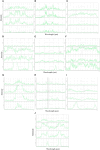Autofluorescence-spectral imaging for rapid and invasive characterization of soybean for pre-germination anaerobic stress tolerance
- PMID: 38476684
- PMCID: PMC10927947
- DOI: 10.3389/fpls.2024.1334909
Autofluorescence-spectral imaging for rapid and invasive characterization of soybean for pre-germination anaerobic stress tolerance
Abstract
The autofluorescence-spectral imaging (ASI) technique is based on the light-emitting ability of natural fluorophores. Soybean genotypes showing contrasting tolerance to pre-germination anaerobic stress can be characterized using the photon absorption and fluorescence emission of natural fluorophores occurring in seed coats. In this study, tolerant seeds were efficiently distinguished from susceptible genotypes at 405 nm and 638 nm excitation wavelengths. ASI approach can be employed as a new marker for the detection of photon-emitting compounds in the tolerant and susceptible soybean seed coats. Furthermore, the accuracy of rapid characterization of genotypes using this technique can provide novel insights into soybean breeding.
Keywords: autofluorescence; imaging; soybean; spectral markers; susceptible; tolerant.
Copyright © 2024 Rajendran, Ramlal, Sarkar, Agasti, Rajarajan, Lal, Raju and Subramaniam.
Conflict of interest statement
The authors declare that the research was conducted in the absence of any commercial or financial relationships that could be construed as a potential conflict of interest.
Figures
Similar articles
-
A Reliable Method to Recognize Soybean Seed Maturation Stages Based on Autofluorescence-Spectral Imaging Combined With Machine Learning Algorithms.Front Plant Sci. 2022 Jun 14;13:914287. doi: 10.3389/fpls.2022.914287. eCollection 2022. Front Plant Sci. 2022. PMID: 35774807 Free PMC article.
-
Autofluorescence-spectral imaging as an innovative method for rapid, non-destructive and reliable assessing of soybean seed quality.Sci Rep. 2021 Sep 8;11(1):17834. doi: 10.1038/s41598-021-97223-5. Sci Rep. 2021. PMID: 34497292 Free PMC article.
-
A seed germination transcriptomic study contrasting two soybean genotypes that differ in terms of their tolerance to the deleterious impacts of elevated temperatures during seed fill.BMC Res Notes. 2019 Aug 19;12(1):522. doi: 10.1186/s13104-019-4559-7. BMC Res Notes. 2019. PMID: 31426836 Free PMC article.
-
Molecular approaches for genetic improvement of seed quality and characterization of genetic diversity in soybean: a critical review.Biotechnol Lett. 2016 Oct;38(10):1645-54. doi: 10.1007/s10529-016-2154-8. Epub 2016 Jun 22. Biotechnol Lett. 2016. PMID: 27334709 Review.
-
Improvement of heat stress tolerance in soybean (Glycine max L), by using conventional and molecular tools.Front Plant Sci. 2022 Sep 26;13:993189. doi: 10.3389/fpls.2022.993189. eCollection 2022. Front Plant Sci. 2022. PMID: 36226280 Free PMC article. Review.
References
-
- Alvarez P. J. C., Krzyzanowski F. C., Mandarino J. M. G., Franca-Neto J. B. (1997). Relationship between soybean seed coat lignin content and resistance to mechanical damage. Seed-Science-and-Technology.
-
- Barboza da Silva C., Oliveira N. M., de Carvalho M. E. A., de Medeiros A. D., de Lima Nogueira M., dos Reis A. R. (2021). Autofluorescence-spectral imaging as an innovative method for rapid, non-destructive and reliable assessing of soybean seed quality. Sci. Rep. 11, 17834. doi: 10.1038/s41598-021-97223-5. - DOI - PMC - PubMed
-
- Buschmann C., Langsdorf G., Lichtenthaler H. K. (2000). Imaging of the blue, green, and red fluorescence emission of plants: an overview. Photosynthetica 38, 483–491. doi: 10.1023/A:1012440903014. - DOI
LinkOut - more resources
Full Text Sources


